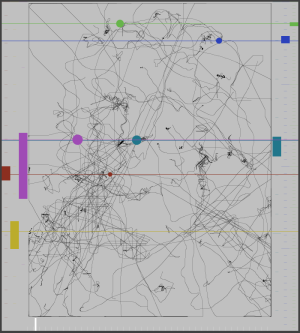etugueScore
start demo (this is a JavaWebStart application. If it does not start have a look at our help page.
ON ETUGUESCORE
etugueScore generates a score based on any given image. It can be interpreted as a "scoregenerator" (composer?). etugueScore is based on our work etugues.
The basic idea of etugues is that no image can be fully comprehended. There is always a randomness in perception. This randomness of perception is especially visible by watching how a blind person traces a sculpture with his/her hands in order to get the form. Our eyes do the same with any image in front of them. In etugues we make this process simplistically visible, i.e in etugues we trace an image by drawing lines. The music in etugues comments on this "tracing perception". Radically formulated this could imply that if the traced image is a landscape than the result of etugues is a kind of automated pastorale. This is our experimental and rather dissecting view on compositions based on images.
In etugues we chose to interprete the image directly as a score in a rather traditional sense. That is we chose to relate a (virtual) linear height scale from top to bottom with high and low notes. The length of the trace between two vertices gives the length of the note.
Of course this is a random choice but a choice which is rooted in a cultural setting. It is a choice which is adapted to the traditional (european) training of musicians. So it allows for very direct experiments of interpreting images as scores. But we also like to experiment with other choices.
With etugueScore we want to invite other musicians to further explore the interface between (raw analyzed) image data and musical interpretation.
For etuguesScore we display the height scale for an open number of instruments on the sides of the image in order to make it better accessible for an instrumental interpretation. The length scale is given by the "jumps" in the scale. Nevertheless both data can be received also directly from the tracing images.
We do not require that the height is directly translated into high and low notes in a well-tempered tune as we did for etugues. We leave that "translation" open to the musicians. We do recommend to use the scale as a scale in order to keep the analyzing and simplifying impetus of the work. The collaboration with an visual artist (for the underlying image (or images see below remark)) is very wellcome, but you can also use the provided image of Johann Sebastian Bach in order to get a little composition with the help of Bach....:-)
If you are interested in the full version of etugueScores then we would like to hear from you!
We want to implement the possibility of pasting a sequence of images into etugueScore, this would allow for a more modular type of composition (like e.g. allegro - andante - allegro a.s.o). We experimented also with colour and internal time (EtugueVideo), however our "personal" time is restricted :-), so the final cast is still in the stage of being on the TODOLIST.
However if you have a strong interest in this then let us know - this could give a boost to our motivation to do the final programming...
Please send an email to etuguesScore@daytar.net.
References:
etugueScore had been included in the collection of soundtoys (April 05) and livingroom (May 05).